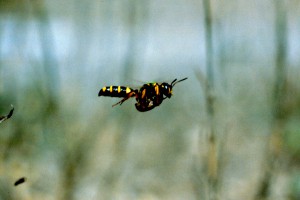Many species of insects including honeybees, ants, and wasps live in nests, which act as headquarters from which all of the members of the colony operate. For an insect such as a wasp, the ability to navigate to and from headquarters accurately is a very important skill. Many nesting insects perform learning flights in order to return home to their nest later.
Researchers Wolfgang Stürzl, Jochen Zeil, Norbert Boeddeker, and Jan M. Hemmi have investigated the learning flights in ground nesting wasps (Sphecidae: Cerceris australis) to understand how the wasps acquire the information during learning flights and how they use that information to guide them back to their nest. In a recent study, these researchers used synchronized high-speed cameras to determine the 3D orientation of the wasp and the wasp’s head position during learning flights and homing flights in order to recreate what a wasp sees during it’s flights. They sought to understand what the wasps were seeing during the learning and homing flights, and how that predicted the wasps’ movement and ability to navigate to the nest.
By analyzing the video, the researchers were able to virtually reconstruct the viewpoint of the wasp (seen above) and identify regular patterns of view and movement. When a learning flight started, the wasp would exit the nest and turn until it faced the nest entrance, the wasp would then perform a series of distinct flight maneuvers, moving back and forth in arcs, keeping its gaze fixed on the nest so that the nest would pass from left to right or right to left in the wasp’s visual field. The arcs became wider as the learning flight progressed. During the learning flight, the wasp would also become aware of other objects that might help direct it to the nest. During a homing flight, the wasp would move in predictable ways when familiar view changes occurred compared to the learning flight, ultimately causing the wasp to navigate home.
Differences in viewpoint over time were calculated and compared during both the learning flights and the homing flights. The similarities in the patterns of gaze and view differences suggested that the wasps were continuously monitoring how their views change and that starting new arcs depended on what the wasp saw during the preceding arcs. The researchers suggested that the wasps used information from the learning flight about the changes in view during subsequent flights to navigate to the nest.
To test their hypothesis, the researchers created a computer simulation where a virtual wasp used this change in view navigation system to return to a virtual nest. Their virtual simulation was successful, supporting their hypothesis on how wasps acquire visual information and use that information for homing.
Many insects use learning flights in order to navigate. This research offers new possibilities for how insects other than wasps may achieve successful navigation. Additionally, a more thorough understanding of flight honing and information processing in insects could provide useful system structures for future artificially intelligent robotic developments
Reference
Stürzl, Wolfgang et al (2016). How Wasps Acquire and Use Views for Homing. Current Biology: n. pag. Web.
Photo and video credit: newscientist.com

